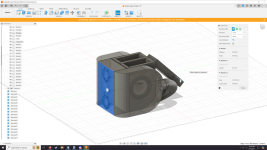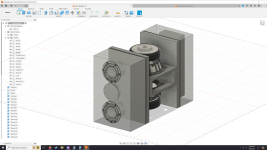So far so good I think. Still need to figure out what I want to do with the back half. I also need to get the actual volume so I know how much space to leave to get the best I can out of the LF drivers.
My answer to the Vas problem. The top and bottom boxes are place-holders for ports. Other than that, no idea how I would do it other than going isobaric and, at that point, defeats the whole point of having push-push woofers.
An old saying comes to mind while doing this. Trying to cram 10 lbs of... stuff in a 5 lb bag. Now I see why there's more than one engineer who usually works on these things lol
It’s not clear what this thing is for……what are your design goals And use case?……is this specific to a single environment/somewhat fixed installation or portable and variable? You mention ‘monitor’……what are you monitoring?
Pretty much a set of work horse monitors that will be full range and have good noise figures. Use case will be for anything from movies to critical listening in the near field to a small room.It’s not clear what this thing is for……what are your design goals And use case?……is this specific to a single environment/somewhat fixed installation or portable and variable? You mention ‘monitor’……what are you monitoring?
Ok so best not to do MTM in the near field unless your working from a console and you need the narrow directivity to reduce bounce off the desk.
Critical listening?…..be mindful…..many of the much loved songs sound pretty awful with a highly revealing system……if you’re working with them trying to make decisions on phase and Eq fine…..otherwise………
Critical listening?…..be mindful…..many of the much loved songs sound pretty awful with a highly revealing system……if you’re working with them trying to make decisions on phase and Eq fine…..otherwise………
I've never heard this thank you for letting me know. Wouldn't an MTM though give me much better lobing in terms of directivity? Isn't that why they do MTMs in the first place?Ok so best not to do MTM in the near field unless your working from a console and you need the narrow directivity to reduce bounce off the desk.
I definitely know there's a difference between listening to Slipknot and listening to Steely Dan 😛Critical listening?…..be mindful…..many of the much loved songs sound pretty awful with a highly revealing system……if you’re working with them trying to make decisions on phase and Eq fine…..otherwise………
I usually listen to music on a set of IE900s on a FIIO M17. But as someone who plays music, I want to be able to hear all the everything the track has to offer so I am better able to appreciate what's happening in it.
I also want to be blown back in my seat when I watch star wars lol
Any lobe is bad…..and more are worse……and the more drivers with distance between playing the same content worse with more and pronounced lobes. Best solution for near field (1 meter or less) ?……coax/coincident 1st, MT/TM 2nd.
Hi, I didn't read the thread, only this last page 😀 And write some comments on morning coffee:
MTM with dome tweeter has only very narrow bandwidth of narrow pattern, which doesn't help that much with any reflections, at least in simulator. So it seems not very logical arrangement.
Also, lobing is just physics and happens with physical transducers we have, if there is a tweeter and it's not coincident with the woofer, because these cannot be close enough physically to prevent it. Coaxials and MEH have it coincident, as well as fullrange driver with possible assisting woofer could do 1/4wl spacing. So, for most speakers there is lobing. If one plays with in a simulator, the graphs actually get better with more sidelobes, iow increased c-c spacing rather than the usual as-close-as possible. DI flattens out. Nulls get closer to on-axis but these seem to be hardly audible on home listening situations, when listening far away compared to acoustics and the early reflections render them less audible. Dips in frequency response in general aren't that audible, not obvious. In this sense fear of lobes seems not logical, just based on fear, and limits design space if bound to it. It's just another design freedom which sometimes is important and sometimes not so much. For example in a nearfield situation one might want to avoid lobing, so then use a coaxial.
This is mostly reasoning based on sims and limited experience, so take as an opinion.
MTM with dome tweeter has only very narrow bandwidth of narrow pattern, which doesn't help that much with any reflections, at least in simulator. So it seems not very logical arrangement.
Also, lobing is just physics and happens with physical transducers we have, if there is a tweeter and it's not coincident with the woofer, because these cannot be close enough physically to prevent it. Coaxials and MEH have it coincident, as well as fullrange driver with possible assisting woofer could do 1/4wl spacing. So, for most speakers there is lobing. If one plays with in a simulator, the graphs actually get better with more sidelobes, iow increased c-c spacing rather than the usual as-close-as possible. DI flattens out. Nulls get closer to on-axis but these seem to be hardly audible on home listening situations, when listening far away compared to acoustics and the early reflections render them less audible. Dips in frequency response in general aren't that audible, not obvious. In this sense fear of lobes seems not logical, just based on fear, and limits design space if bound to it. It's just another design freedom which sometimes is important and sometimes not so much. For example in a nearfield situation one might want to avoid lobing, so then use a coaxial.
This is mostly reasoning based on sims and limited experience, so take as an opinion.
Last edited:
Quick sims with ideal drivers to accompany, MTM makes about two octaves wide bump in DI. Better put this at critical bandwidth where it matters, or does it matter? two woofers increase headroom at least, perhaps the directivity also matters in some use cases. Never had MTM so this is just speculation.
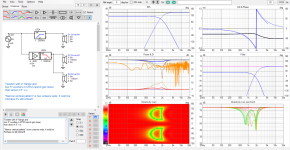
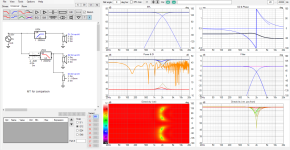
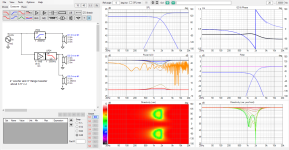
Here effect of c-c in MT. 0.7wl c-c is about as close as anyone gets with 4" tweeter flange and 5" woofer in this case. Next images show when it's increased up to double 1.4wl spacing, which could almost fit another 5" between the tweeter and woofer and it's still about the same, there is lobing and c-c just adjusts which vertical angles get it better or worse, which might matter or not. DI gets better by increasing c-c and adding additional sidelobes.

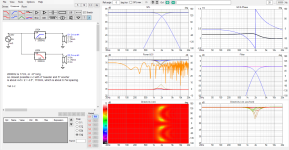
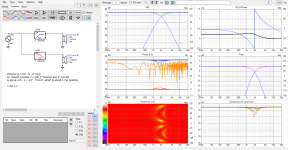
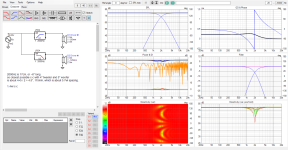



Here effect of c-c in MT. 0.7wl c-c is about as close as anyone gets with 4" tweeter flange and 5" woofer in this case. Next images show when it's increased up to double 1.4wl spacing, which could almost fit another 5" between the tweeter and woofer and it's still about the same, there is lobing and c-c just adjusts which vertical angles get it better or worse, which might matter or not. DI gets better by increasing c-c and adding additional sidelobes.




Last edited:
The OP mentioned a near field situation so I attempted to steer him away from an MTM application…..of which I’m a fan of in the mid to far field where the power handling of two midwoofers might be needed and the increased vertical directivity may be a side benefit. Even in those cases, I prefer a .5 situation on the alignment.Nulls get closer to on-axis but these seem to be hardly audible on home listening situations, when listening far away compared to acoustics and the early reflections render them less audible. Dips in frequency response in general aren't that audible, not obvious. In which sometimes is important and sometimes not so much. For example in a nearfield situation one might want to avoid lobing, so then use a coaxial.
This is mostly reasoning based on sims and limited experience, so take as an opinion.
My extensive experience with small room near field monitoring has led me to a coax/coincident solution as well. I’ve found that acoustic room treatments to at least the essentials are also imperative in a small space. some of the methodology being applied these days seems to be centered around the highest quality drivers with very low HD profiles in near field critical listening situations to hear every nuance and detail in a recording………..and I strongly reject that notion if the use case is NOT a working/productivity application……..it all sounds fatiguing, grating and just not much fun after half an hour. It didn’t take very long for my ears to learn they were useless in making any kind of decisions once fatigue sets in. With the coax application, I can work a little longer as the phase coherence is so precise enough to expose mid side problems when panning and breathing or pulsing compression artifacts to tell me I’ve squeezed it too much…..something I can’t do well when fatigued as my ear/brain is already doing the squeezing.
Last edited:
Then ‘ beam away Scotty’ ( lol, yes….wrong movie!) and get everything you actually need with a 1” compression driver mated to a constant directivity lens paired with an 8” midwoofer than can give you direct midbass before the room takes over. Cross low as power handling won’t be a factor for the CD driver. Don’t use a metal diaphragm and build it around a 2x4 DSP unit so you can EQ out any response bumps in the treble…….no dome tweeter will be able to match the detail or low HD by a long shot.I want to be able to hear all the everything the track has to offer so I am better able to appreciate what's happening in it.
I also want to be blown back in my seat when I watch star wars lol
Only reason I'm not going coax is I just haven't found one I liked. I've even tried out blade 1 and 2 and it just didn't sound as good as a speaker compliment with woofers and a beryllium tweeter. From a raw data stand point, the SP1815 mid doesn't test as well as a purifi driver, and the HF doesn't test as well as a T25B. The only other coax I can think of that quality is the one that genelec uses on their "the ones" series and at that point I would just be getting genelecs (which I don't think I will because my wallet would not like that lol)My extensive experience with small room near field monitoring has led me to a coax/coincident solution as well. I’ve found that acoustic room treatments to at least the essentials are also imperative in a small space. some of the methodology being applied these days seems to be centered around the highest quality drivers with very low HD profiles in near field critical listening situations to hear every nuance and detail in a recording………..and I strongly reject that notion if the use case is NOT a working/productivity application……..it all sounds fatiguing, grating and just not much fun after half an hour. It didn’t take very long for my ears to learn they were useless in making any kind of decisions once fatigue sets in. With the coax application, I can work a little longer as the phase coherence is so precise enough to expose mid side problems when panning and breathing or pulsing compression artifacts to tell me I’ve squeezed it too much…..something I can’t do well when fatigued as my ear/brain is already doing the squeezing.
I've looked high and low at compression drivers. The closest I've found to matching a dome tweeter in performance is the textreme driver from eminence. Otherwise I would be sinking the entire cost of the speaker into a higher end compression driver, and even then it wouldn't reach the same level as a dome.Then ‘ beam away Scotty’ ( lol, yes….wrong movie!) and get everything you actually need with a 1” compression driver mated to a constant directivity lens paired with an 8” midwoofer than can give you direct midbass before the room takes over. Cross low as power handling won’t be a factor for the CD driver. Don’t use a metal diaphragm and build it around a 2x4 DSP unit so you can EQ out any response bumps in the treble…….no dome tweeter will be able to match the detail or low HD by a long shot.
The solution actually is to switch from the T25B to the T34B. The T34B allows for a much lower crossover point which in turn means more bandwidth for said crossover to occur. This should prevent the typical issues you would have with an MTM. Perlisten speakers kinda do the same thing with their tweeter array, except I'm just using one tweeter instead of three.
Some updates:

I thought I would try an isobaric design for grins. Half Vas is kind of a nice trade off for 3db. For a smallish build like this, that seems more ideal. I also decided to switch to a different LF driver. https://www.daytonaudio.com/images/resources/295-458-dayton-audio-rss210ho-4-specifications.pdf this should allow for a smaller enclosure space without sacrificing too much in the way of sensitivity (even though it's technically a slightly larger driver.

I was toying with this configuration, but not sure what you would call it. The idea is while one speaker pushes, dragging in pressure as it does, the other pulls with the addition inertia of the bottom driver. When the poles reverse, so does the process. I could also see this not working because of a lack of a sealed volume of air in which the driver can recoil against. Would like an expert opinion on this one.
I thought I would try an isobaric design for grins. Half Vas is kind of a nice trade off for 3db. For a smallish build like this, that seems more ideal. I also decided to switch to a different LF driver. https://www.daytonaudio.com/images/resources/295-458-dayton-audio-rss210ho-4-specifications.pdf this should allow for a smaller enclosure space without sacrificing too much in the way of sensitivity (even though it's technically a slightly larger driver.
I was toying with this configuration, but not sure what you would call it. The idea is while one speaker pushes, dragging in pressure as it does, the other pulls with the addition inertia of the bottom driver. When the poles reverse, so does the process. I could also see this not working because of a lack of a sealed volume of air in which the driver can recoil against. Would like an expert opinion on this one.
Looks like a 6th order bandpass with an isobaric driver setup. However, paralleling drivers makes sure that the sensitivity is not lower. Series wiring cannot make up for the losses.
Actually I was just gonna section off the MTM and probably just give the LF drivers enough room to complete the function and only do a single port. WinISD says it liked one port better so that's what I'm going with. It only needs 20 to 30 liters and about a 15 inch port.Looks like a 6th order bandpass with an isobaric driver setup. However, paralleling drivers makes sure that the sensitivity is not lower. Series wiring cannot make up for the losses.
Edit: since I'm going with hypex I can get the 4 ohm versions and tun them at 2
Last edited:
I think this is our winner. A few other things I need to figure out and I'm golden.
1) Port orientation, entrance, and exit, as well as material.
2) Decoupling the MTM mechanically from the chassis (I've read rubber bushings?)
3) Anything else that needs to be done with the subs like flaring out the holes in the front etc.
4) Bracing bracing bracing.
- Home
- Loudspeakers
- Multi-Way
- Project: Shakespeare
